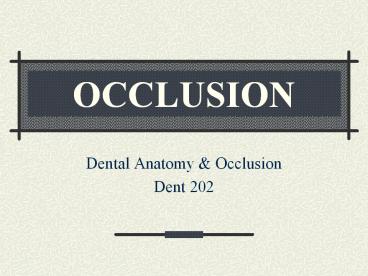OCCLUSION - PowerPoint PPT Presentation
1 / 17
Title: OCCLUSION
1
OCCLUSION
- Dental Anatomy Occlusion
- Dent 202
2
Occlusion
- Definition
- The act of closure or being closed
- A static morphological tooth contact relationship
- Includes all factors concerned with the
development and stability of the masticatory
system and the use of teeth in oral motor
behavior - Includes the integrated system of functional
units involving teeth, joints and muscles of the
head and neck
3
Concepts of occlusion
- Balanced occlusion
- Bilateral contacts in all functional excursions
- Prevent tipping of the denture bases
- Not necessarily existing in natural dentition
because each tooth is a separate unit - Intercuspal position
- Centric occlusion
- Concepts developed in relation to orthodontics,
complete dentures and full mouth rehabilitation - None are completely applicable to natural
dentition
4
Overview of primary occlusion
- Each tooth occludes with 2 teeth of the opposing
jaw - Exceptions
- Mandibular central incisor
- Maxillary second molar
- Occlusion is supported and made more efficient
after eruption of first permanent molars - Interdental spacing is important for future
sufficiency of space in permanent teeth - Probability of crowding in permanent teeth is
related to the amount of interdental spacing in
primary dentition
5
Primary molar relationship
- Terminal plane relationship
- Flush
- 56 - Class I Angles molar relationship
- 44 - Class II Angles molar relationship
- Distal step
- Class II Angles molar relationship
- Mesial step
- A greater probability for Class I Angles molar
relationship - A lesser probability for Class III Angles molar
relationship
6
Primary molar relationship
- Factors influencing the effect of terminal plane
relationship on Angles molar relationship - Differential growth of the jaw
- Forward growth of the mandible
- Sufficient Leeway space to accommodate a mesial
shift of the permanent molars - Leeway space is the amount of space gained by the
difference in the mesiodistal diameter between
deciduous molars and premolars
7
Permanent occlusion
- Anteroposterior relationship
- Incisors Class I, II, III
- Canine Class I, II, III
- Molars Angles Class I, II, III
- Faciolingual relationship
- Premolars
- Molars
8
Incisal relationship
- Class I
- Class II
- Class III
- Overjet
- Reverse
- overjet
- Overbite
9
(No Transcript)
10
Canine relationship
- Class I
- Class II
- Class III
11
Molar Occlusal relationship
- Angles Class I
- Angles Class II
- Angles Class III
12
Arch Occlusal relationship
13
Curves of occlusion
- Curve of Spee
- Curve of Wilson
- Sphere of Monson
14
Inclination angulation of the roots of the teeth
- Mandibular arch is wider than maxillary arch
- Each tooth must be placed at the angle that best
withstands the line of forces brought against it
during function - If the tooth is placed at a disadvantage, its
longevity may be at risk - Anterior teeth are placed at a disadvantage
15
Antagonists
- With the exception of mandibular incisors and
maxillary third molars, each tooth contacts two
antagonist teeth in the opposing arch - Loss of one tooth keeps the adjacent tooth in
contact with opposing antagonist - Mesial or distal drifting into the space disturbs
occlusal contact with antagonist teeth
16
Centric stops
- Lingual cusp tips of maxillary posterior make
contact with opposing fossae and marginal ridges
of mandibular posterior teeth - Buccal cusp tips of mandibular posterior make
contact with opposing fossae and marginal ridges
of maxillary posterior teeth - Lingual cusps of maxillary posterior teeth and
buccal cusps of mandibular posterior teeth are
called supporting cusps - Areas of occlusal contact that a supporting cusp
make with opposing teeth in centric occlusion are
centric stops - The tip of that cusp is also a centric stop
- Knowledge of centric stops are important in
restorative dentistry
17
Movements away from centric occlusion
- Lateral
- Working side
- Non-working side
- In complete dentures
- Balancing side
- Non-balancing side
- Movement in TMJ
- Tooth guidance
- Group function
- Canine guidance
- Protrusive
- Incisal guidance
- Retrusive
- The most retrusive position is the centric
occlusion in complete dentures































